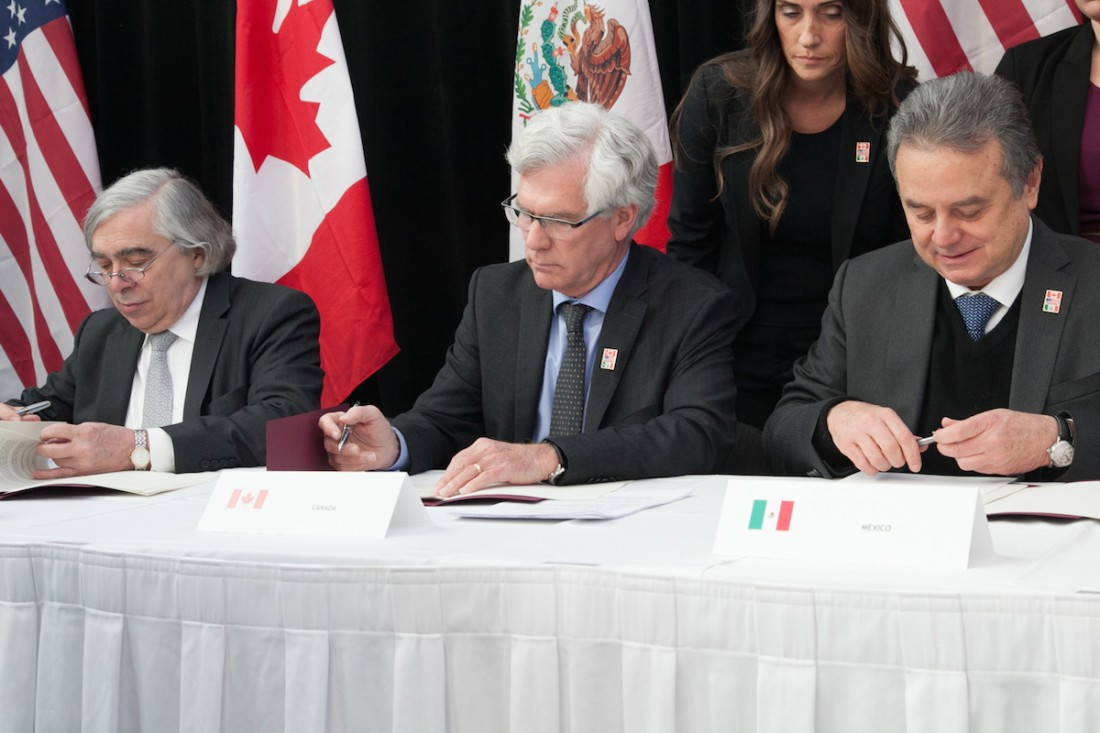Will it stay in the ground?
Clean energy agreement leaves questions about fossil fuel production
As North American energy ministers signed an agreement for continent-wide cooperation on clean energy, a one-man protest highlighted the urgent need to limit fossil fuel production.
On Feb. 11 and 12, Natural Resources Minister Jim Carr and his Mexican and American counterparts, Pedro Joaquin Coldwell and Dr. Ernest Moniz, met and signed the Memorandum of Understanding on Climate Change and Energy Collaboration at Manitoba Hydro Place in Downtown Winnipeg.
While the press was snapping pictures, Riley McMurray stepped in front of the cameras with a sign that read “Keep It In The Ground.”
After a few words about pipelines, he said, “We must leave 80 per cent of fossil fuels in the ground if we are to meet Trudeau’s lofty goal that he agreed to in Paris of 1.5 degrees Celsius. We need to transition to a renewable alternative energy economy in Alberta in solidarity with Albertan workers.”
After Minister Carr acknowledged the protest, the young man was escorted out quietly. The press conference continued with an upbeat message.
“This memorandum takes the important strides we’ve made in recent years towards a continental approach to energy,” Carr said, “and expands our relationship in support of an even more ambitious clean energy and environmental agreement.”
Carr announced that for the first time, North American energy maps and data have been brought together on one platform. Canada, the U.S. and Mexico will also work together on low-carbon energy development and deployment, carbon capture and storage, energy efficiency, and reducing emissions from the oil and gas sector.
Soon, the media was calling this a step towards a “green NAFTA” and McMurray was characterized as a pipeline protester “allowed to say his piece.”
However, according to Douglas Tingey, a carbon finance lawyer and member of the Winnipeg chapter of the Council of Canadians, that “piece” should be part of the conversation.
“I’m very happy that people are looking to spend more money on renewable energy and better ways of doing things. But there’s another problem that has to be solved at the same time... now. Not over 10, 15, 20 years, hoping that technologies are going to come in and save us.”
As part of Mission Innovation, a global clean energy partnership, Canada will double government investment in clean energy over the next five years.
While the Intergovernmental Panel on Climate Change has set a global carbon budget limiting global temperature rise to two degrees Celsius above pre-industrial levels, energy companies already have five times the remaining budget in their reserves, and “carbon budget” is not in the Canadian political vocabulary, Tingey says.
“Our commitment to reduce (emissions) is not part of an international budgeting process,” Tingey says.
Tingey also explains that the government only counts emissions within Canada, not those that occur when Canadian fuels are burned in other countries.
For his part, McMurray is thrilled that his protest got the “counter-narrative” out there.
“It was amazing. It was so fantastic.”
“At least five or six different media outlets covered the story.”
Published in Volume 70, Number 21 of The Uniter (February 25, 2016)








